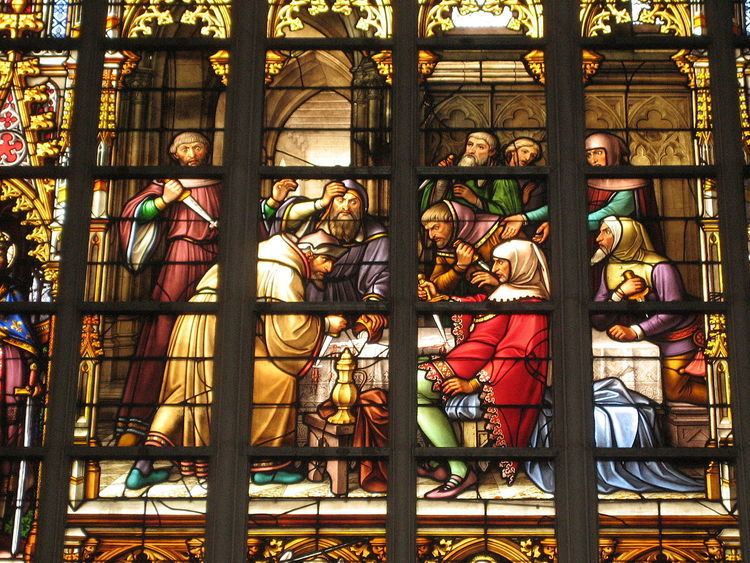 | ||
The Brussels massacre was an anti-Semitic episode in Brussels in 1370 in connection with an alleged host desecration at the Brussels synagogue. A number of Jews, variously given as six or about twenty, were executed or otherwise killed, while the rest of the small community was banished. The event was commemorated by local Christians as the Sacrament of Miracle, as it was said that the desecrated hosts stabbed by a Jew had miraculously shed blood and been otherwise unharmed. The cult of the putative miracle survived until after the Second World War.
Contents
Background
Black Death Jewish persecutions had previously destroyed Brussels' community in 1350. Host desecration was a common anti-Semitic canard in medieval Europe, and the wafers the Jews were supposed to have tried to profane were often said to have been miraculously spared from harm. In 1369, two priests in Brussels were arrested for usury and turned over to the ecclesiastical tribunal of the Church of Saints Michael and Gudula (now the cathedral) for investigation: it transpired that they had attempted to circumvent usury prohibitions by lending money to a Jew named Mesterman who in turn lent it out at interest. The clerical usury scandal in Brussels was the immediate context of the accusations of host desecration. According to Premonstratensian historian Placide Lefèvre, contemporary treasury records indicate that there were eight Jewish households in Brussels and two in Leuven.
Allegations
The version of the allegations attested from 1403 was that a rich Jew from Enghien wanted to obtain some consecrated hosts to profane, and bribed a male Jewish convert to Christianity from Louvain to steal some. Shortly thereafter, the Enghien merchant was murdered. His widow passed the stolen hosts to the Jews of Brussels, where in the synagogue on Good Friday 1370 some tried to stab the wafers with their daggers, causing blood to pour forth. A female Jewish convert to Christianity was paid to take the hosts to Cologne's Jews, but remorsefully told the story to the parson of Notre-Dame de la Chapelle in Brussels, who took possession of the hosts. The Duke of Brabant, on the woman's testimony, ordered the stabbers burnt at the stake and the remaining Jews banished, with their property confiscated.
Cult of the Miracle
The hosts were placed in reliquaries and preserved in the chapel of Saint Gudula, the patron saint of Brussels, an important symbol of the area's Catholic identity. They became a feature of the annual procession on her feast day. Ten stained-glass windows depicting the putative miracle were donated to the chapel in the 16th Century by Emperor Charles V. This compared perceived Jewish anti-Catholicism to the nascent Protestant Reformation, with the miraculous bleeding countering Protestant denials of transubstantiation.
In the early 1580s, during a period of Calvinist rule in Brussels, all Catholic ceremonies were suppressed. From 1579 to 1585 the relics had been hidden in a house in the Korte Ridderstraat. After the end of Calvinist rule in 1585, a procession of citizens and officeholders had retrieved the hosts and carried them back to the church. The re-emergence of the cult in 1585 was primarily as a celebration of the end of Calvinist rule. The Archdukes Albert and Isabella, who ruled in Brussels 1598–1621, made the annual procession a state occasion:
The Blessed Sacrament of Miracles ... had emerged as doubly miraculous after the end of Calvinist rule in Brussels in 1585 when it became clear that the sacred hosts had survived intact. The annual procession in honour of the Sacrament now became as much a commemoration of the second anti-Calvinist miracle as of the first anti-Semitic one and, after their accession, the Archdukes conscientiously attended the procession every year while also turning it into a veritable state event.
Five windows added in the nineteenth century depict the development of the cult of the Miracle; these were donated by Belgian kings Leopold I and Leopold II and other nobles, this time linking the Miracle to the contemporary Catholic opposition to secularism. The 1870 quincentenary of the Miracle was marked with celebrations.
Retraction
After the Second World War, in light of the mass murder of Belgian Jews during The Holocaust, the anti-semitic elements of the cult were de-emphasised. In 1968, in the wake of Nostra aetate issued by the Second Vatican Council, the Archdiocese of Mechelen-Brussels officially derecognised the cult. In 1977 Cardinal Leo Joseph Suenens installed a plaque in the cathedral to highlight this. On November 16, 2006 at the inauguration of the exhibit Menorah in the Cathedral by Jean Paul Leon presented by the Jewish Museum of Belgium, Monsignor De Kesel addressed the attendees and Albert Guigui as Chief Rabbi of the Great Synagogue of Europe and apologised for the commemoration of the Brussels massacre on the windows of the Cathedral. The former chapel of Saint Gudula is now the cathedral museum, displaying its treasures, including the former reliquaries, with contextual information.
